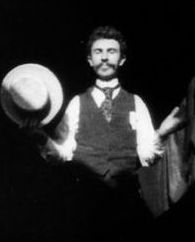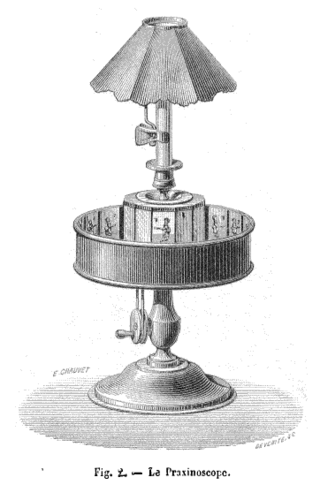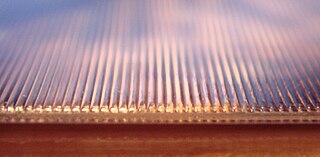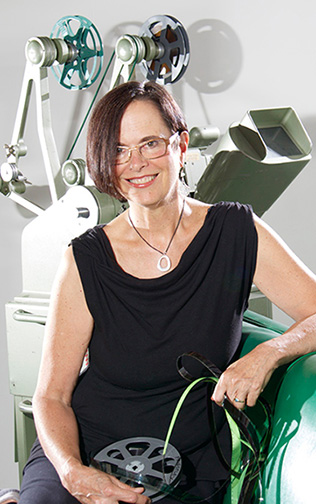
Animation is the method that encompasses myriad filmmaking techniques, by which still images are manipulated to create moving images. In traditional animation, images are drawn or painted by hand on transparent celluloid sheets (cels) to be photographed and exhibited on film. Animation has been recognized as an artistic medium, specifically within the entertainment industry. Many animations are computer animations made with computer-generated imagery (CGI). Stop motion animation, in particular claymation, has continued to exist alongside these other forms.

William Kennedy Laurie Dickson was a British inventor who devised an early motion picture camera under the employment of Thomas Edison.

A zoetrope is one of several pre-film animation devices that produce the illusion of motion by displaying a sequence of drawings or photographs showing progressive phases of that motion. It is a cylindrical variation of the phénakisticope, suggested almost immediately after the stroboscopic discs were introduced in 1833. The definitive version, with easily replaceable picture strips, was introduced as a toy by Milton Bradley in 1866 and became very successful.
Visual effects is the process by which imagery is created or manipulated outside the context of a live-action shot in filmmaking and video production. The integration of live-action footage and other live-action footage or CGI elements to create realistic imagery is called VFX.

The Mutoscope is an early motion picture device, invented by W. K. L. Dickson and Herman Casler and granted U.S. Patent 549309A to Herman Casler on November 5, 1895. Like Thomas Edison's Kinetoscope, it did not project on a screen and provided viewing to only one person at a time. Cheaper and simpler than the Kinetoscope, the system, marketed by the American Mutoscope Company, quickly dominated the coin-in-the-slot peep-show business.

The praxinoscope was an animation device, the successor to the zoetrope. It was invented in France in 1877 by Charles-Émile Reynaud. Like the zoetrope, it used a strip of pictures placed around the inner surface of a spinning cylinder. The praxinoscope improved on the zoetrope by replacing its narrow viewing slits with an inner circle of mirrors, placed so that the reflections of the pictures appeared more or less stationary in position as the wheel turned. Someone looking in the mirrors would therefore see a rapid succession of images producing the illusion of motion, with a brighter and less distorted picture than the zoetrope offered.

Lenticular printing is a technology in which lenticular lenses are used to produce printed images with an illusion of depth, or the ability to change or move as they are viewed from different angles.

Precursors of film are concepts and devices that have much in common with the later art and techniques of cinema.

The Kinora was an early motion picture device developed by the French inventors Auguste and Louis Lumière in 1895, while simultaneously working on the Cinematograph. It was patented in February 1896.

The Machin series of postage stamps is the main definitive stamp series in the United Kingdom, used since 5 June 1967. It is the second series to figure the image of Elizabeth II, replacing the Wilding series. The last issue was on 4 April 2022, four months before her death on 8 September.

Joanna Priestley is an American contemporary film director, producer, animator and teacher. Her films are in the collections of the Academy Film Archive in Los Angeles and the Museum of Modern Art in New York. Priestley has had retrospectives at the British Film Institute, Museum of Modern Art and Hiroshima International Animation Festival in Japan. Bill Plympton calls her the "Queen of independent animation". Priestley lives and works in Portland, Oregon.

The postage stamps and postal history of Israel is a survey of the postage stamps issued by the state of Israel, and its postal history, since independence was proclaimed on May 14, 1948. The first postage stamps were issued two days later on May 16, 1948. Pre-1948 postal history is discussed in postage stamps and postal history of Palestine.

Olivier Cotte is a French writer, graphic novel scriptwriter, animation historian, illustrator, and a director.
Ding Huan was a Chinese craftsman, mechanical engineer, and inventor who lived in the first century BC during the Han dynasty. Among the inventions attributed to him is an air conditioning system based on evaporative cooling.
Art of Disney Animation is an attraction at the Disney California Adventure in Disneyland Resort and Hong Kong Disneyland in Hong Kong Disneyland Resort. In Walt Disney Studios Park, the attraction opened on March 16, 2002 in the Toon Studio area, but was closed on January 7, 2019. It was reopened on November 17, 2019.

A film – also called a movie, motion picture, moving picture, picture, photoplay or (slang) flick – is a work of visual art that simulates experiences and otherwise communicates ideas, stories, perceptions, feelings, beauty, or atmosphere through the use of moving images. These images are generally accompanied by sound and, more rarely, other sensory stimulations. The word "cinema", short for cinematography, is often used to refer to filmmaking and the film industry, and the art form that is the result of it.

Patrick Jenkins is a Canadian artist, animator and documentary filmmaker living in Toronto, Ontario, Canada, who specializes in paint-on-glass animation, a form of stop motion animation.

Barrier-grid animation or picket-fence animation is an animation effect created by moving a striped transparent overlay across an interlaced image. The barrier-grid technique originated in the late 1890s, overlapping with the development of parallax stereography (Relièphographie) for 3D autostereograms. The technique has also been used for color-changing pictures, but to a much lesser extent.
Takeshi Murata is an American contemporary artist who creates digital media artworks using video and computer animation techniques. In 2007 he had a solo exhibition, Black Box: Takeshi Murata, at the Hirshhorn Museum and Sculpture Garden in Washington, D.C. His 2006 work "Pink Dot" is in the Hirshhorn's permanent collection, and his 2005 work "Monster Movie" is in the permanent collection of the Smithsonian American Art Museum. His 2013 short film "OM Rider" was selected to screen as an animated short film at the 2015 Sundance Film Festival.
For the history of animation after the development of celluloid film, see history of animation.
















